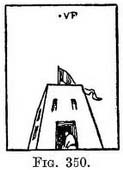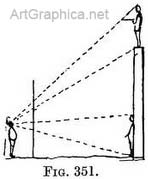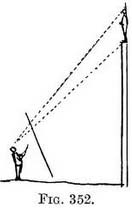Unusual Perspective |
||||||||||||||||
|
Page 19 / 25
 CHAPTER XVIII PERSPECTIVE FROM UNUSUAL POINTS OF VIEWTHE great painters of old were content to take a quite usual view of a subject, relying on their mastery of composition, colour and tone, for the making of a work of art. Such pictures by their sense of beauty and dignity command respect. Modern unrestfulness and changed conditions call for novelty ; the jaded taste of the public must be excited by freak drawings and amused by eccentricity. Some one or other obligingly lies on his back and depicts a steeplejack at his work, and shows the sides of the cathedral towers receding to a point in the heavens above ; so he is reckoned a very smart fellow. Another may sketch our country as seen from, aircraft with houses wider at their roofs than at their base, and side walls tapering to their foundations. Authors of such as these are mistaken in hanging their productions on a vertical wall. The picture of a tower seen from the sky must, to look correct, lie on the floor ; while the steeplejack picture should be pasted to the ceiling. Quite apart from art, there is a use for drawings made from the earth looking skyward, and for a view of the sky ; nor is there difficulty in making them except for their exercise in gymnastics, for the old rules of perspective still hold good, and we require no new ones. (1) Looking down from a bridge. — If your fancy leads you to sketch the Thames as seen through a chink in the footpath of the Tower Bridge, you have but to shed a tear, and where it splashes a hundred feet below you, will be your point of sight and consequent P.V.P. on your paper. The mast of the ship below (if vertical) will tend towards the P.V.P., and will be subject to the usual rules of foreshortening ; the rim of the steamer's funnel will hide its base, or if it is a little to one side of you, the funnels will taper to the deck. The eddies on the water will appear as unforeshortened curves or circles, just as their ground plan would be drawn. (2) From an airship. — Can you dream that you are in front of a huge wall and some houses are sticking out from it, in such a way that the wall is where the inhabitants' floor should be, and you yourself are facing the roof ? If you then drew those houses using exactly the old rules of perspective, your drawing would seem to have been taken from an airship.
Again, pictures with a very high horizon should be hung low down on a wall, and, if practicable, with their base tilted out, so that the spectator may be looking down on the subject as the painter wag. It follows that those with a low horizon can be placed higher so that we also may look up to the scene. When scenery has to be viewed from different points of view, as in a theatre, dodges must be resorted to, in order to make them appear naturalistic ; again, the circular representation of the panorama had its use.
If, therefore, we wish to paint a figure standing on a height (Fig. 351)—say a tower—and another at its base, we should take up a position far enough away to include both without having to look up and down, and the figures would appear to be the same height, or our composition might include only the upper part of the tower, in which case (Fig. 352) it could be studied near at hand. In mural paintings the figures or other objects high up on the wall will have to be progressively larger than those at the level of our eye, if they both are to appear in the same proportion ; more particularly so when, from insufficient floor space, a near view becomes a necessity. If you draw a small single object, say an upright cup, you could represent its circumference as being more circular in shape than if you painted many cups ; the reason being that you can look down on one cup close at hand, but to see many you would have to go further away and their rims would become more oval. If you represent a cup with a circular rim and yet include the room beyond it, you suppose your eye capable of taking in a larger angle than is natural and your drawing looks distorted, or the rim of the cup appears to be tilted towards you. We may conjecture that if you revel in elaborate detail you can use a rather wide angle of vision, because your picture will be examined at close quarters ; while the beauty of the detail would be missed if your work, to seem correct, has to be looked at from across the room. In fact, if you had chosen a long-distance view, you would be ill-advised in introducing detail at all ; it would look unnatural and lessen the grand qualities that blank spaces of fine tone and colour possess. The surface of the paint itself should automatically register the distance the painter was from his subject ; rough paint, unintelligible (except to an artist) if closely examined, compels the owner of the picture to stand back until he can focus the whole canvas, then the blotches and smears resolve themselves into beautiful drawing and the owner desists from again attempting to see the work from a wrong point of view. Perhaps little pictures should have a short D.V.P., and big pictures one far away—but I won't be led on to dogmatise ; and when painting is concerned I hate a controversy.
Next Page
Perspective in Paintings Prev Page How to Draw Boats
|
||||||||||||||||
 (3) At the Sky. - If you lie on your back to sketch (Fig. 350), the P.V.P. will be amongst the stars directly over your head and all upright lines will recede to it. The only thing to cause trouble is the novelty of the point of view. You must, however, remember that you cannot include the ground or the base of the building ; also that to see your finished drawing you should hold it over your head. Incidentally we may add that in ceiling paintings the point of sight is placed overhead among the floating figures.
(3) At the Sky. - If you lie on your back to sketch (Fig. 350), the P.V.P. will be amongst the stars directly over your head and all upright lines will recede to it. The only thing to cause trouble is the novelty of the point of view. You must, however, remember that you cannot include the ground or the base of the building ; also that to see your finished drawing you should hold it over your head. Incidentally we may add that in ceiling paintings the point of sight is placed overhead among the floating figures.
 The position of the painter in regard to his subject and that of the spectator to the picture has already been alluded to. It is one of the theoretical canons of painting that only so much of the subject shall be included as can be seen without moving the head. In practice this is not literally adhered to. Fin. 351. By understanding perspective one can give the appearance of the rule having been observed.
The position of the painter in regard to his subject and that of the spectator to the picture has already been alluded to. It is one of the theoretical canons of painting that only so much of the subject shall be included as can be seen without moving the head. In practice this is not literally adhered to. Fin. 351. By understanding perspective one can give the appearance of the rule having been observed.





